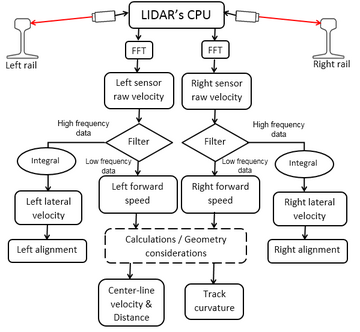| Project Title | Application of Doppler LIDAR sensors for assessing track gauge widening in curves and locations with high-lateral forces |
|---|---|
| University | Virginia Tech |
| Principal Investigator | Mr. Carvel Holton, Dr. Mehdi Ahmadian |
| PI Contact Information | Center for Vehicle Systems and Safety, MC-0901, 3103 Commerce Street, Virginia Tech, Blacksburg, VA 24061 |
| Funding Source(s) and Amounts Provided (by each agency or organization) |
DOT — RailTEAM: $60,000 Virginia Tech Matching Fund: $30,000 |
| Total Project Cost | $75,000 |
| Agency ID or Contract Number | |
| Start and End Dates | September 1, 2019 — August 31, 2020 |
| Brief Description of Research Project |
The application of Doppler-based, Light Detection and Ranging (LIDAR) technology for determining track lateral irregularities, specifically track alignment and gage variation, are investigated. The proposed method uses track measurements by two low-elevation, slightly tilted LIDAR sensors nominally pointed at the rail gage face on each track. The LIDAR lenses are installed with a slight forward angle to measure track speed in both longitudinal and lateral directions. The lateral speed measurements are processed for assessing the track gage and alignment variations, using a method that is based on the frequency bandwidth dissimilarities between the vehicle speed and track geometry irregularity. Lateral track geometry is described by track alignment and gage. Track alignment is defined in term of variation in the lateral positions of the left and right rails from a mean trajectory over a specific length of the track. Alignment can be measured manually using chord based approaches, where the lateral offset of the rail from the center of a string stretched between two ends touching the rail side is obtained at multiple locations. In addition, gage is defined as the distance between the two rails measured 5/8 inches from the top of each rail. Gage can be measured manually using a gage measuring stick. Excessive track gage variations lead to large lateral wheel and axle forces, which could lead to a derailment, excessive body acceleration, and damage to the track structure. |
| Describe Implementation of Research Outcomes (or why not implemented) | The research heavily relies on field testing on board a Hy-rail vehicle. The analysis of the data will be closely tied to the maintenance of the way practices. The implementation of the research outcome will be continually occurring throughout the course of the project. |
| Place any photos here | 
|
| Impacts/Benefits of Implementation (actual, not anticipated) | The railroads continually aim to improve the maintenance of the way practices through using more advanced measurements and data analysis methods. This project will provide a non-contacting method for measuring track gage, beyond the manual methods that are currently adopted. There are no major barriers to implementing the technology for maintenance of the way improvements. We anticipate that the system will be implemented readily by the U.S. railroads. Once implemented, the new method is expected to have a major impact on condition-based maintenance of the track, which in turn will have a significant effect on improving safety and reducing maintenance of the way costs. |
| Web Links |
Principal Investigator/Researcher
Mr. Carvel Holton, Dr. Mehdi Ahmadian Virginia Tech
Start September 1, 2019
End: August 31, 2020
Project Description
The application of Doppler-based, Light Detection and Ranging (LIDAR) technology for determining track lateral irregularities, specifically track alignment and gage variation, are investigated. The proposed method uses track measurements by two low-elevation, slightly tilted LIDAR sensors nominally pointed at the rail gage face on each track. The LIDAR lenses are installed with a slight forward angle to measure track speed in both longitudinal and lateral directions. The lateral speed measurements are processed for assessing the track gage and alignment variations, using a method that is based on the frequency bandwidth dissimilarities between the vehicle speed and track geometry irregularity.
Lateral track geometry is described by track alignment and gage. Track alignment is defined in term of variation in the lateral positions of the left and right rails from a mean trajectory over a specific length of the track. Alignment can be measured manually using chord based approaches, where the lateral offset of the rail from the center of a string stretched between two ends touching the rail side is obtained at multiple locations. In addition, gage is defined as the distance between the two rails measured 5/8 inches from the top of each rail. Gage can be measured manually using a gage measuring stick. Excessive track gage variations lead to large lateral wheel and axle forces, which could lead to a derailment, excessive body acceleration, and damage to the track structure.
Implementation of Research Outcomes
The research heavily relies on field testing on board a Hy-rail vehicle. The analysis of the data will be closely tied to the maintenance of the way practices. The implementation of the research outcome will be continually occurring throughout the course of the project.

Impacts/Benefits of Implementation
The railroads continually aim to improve the maintenance of the way practices through using more advanced measurements and data analysis methods. This project will provide a non-contacting method for measuring track gage, beyond the manual methods that are currently adopted. There are no major barriers to implementing the technology for maintenance of the way improvements. We anticipate that the system will be implemented readily by the U.S. railroads. Once implemented, the new method is expected to have a major impact on condition-based maintenance of the track, which in turn will have a significant effect on improving safety and reducing maintenance of the way costs.